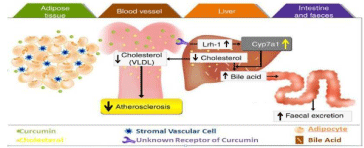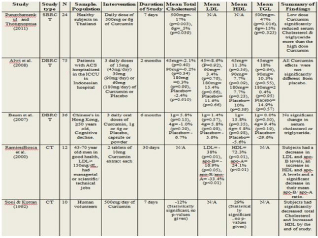
Review Article
Austin J Obes & Metab Synd. 2020; 4(1): 1012.
Anti- Hyperlipidemia Properties of Curcumin
Bablani P*, Shamsi Y, Kapoor P and Sharma M
Clinical Research Operations at Datt Med Products, India
*Corresponding author: Pankaj Bablani, Clinical Research Operations at Datt Med Products, India
Received: January 06, 2020; Accepted: February 07, 2020; Published: February 14, 2020
Abstract
Aim: To evaluate the effects of Curcumin on total cholesterol, LDL cholesterol, HDL cholesterol, and Triglyceride in acute hyperlipidemia.
Introduction: Dyslipidemias, (Including hyperlipidemia and low HDL cholesterol levels) is a major cause of atherosclerosis and atherosclerosisinduced Coronary Heart Disease (CHD), and accounts for about one third of all deaths in the middle aged and older adults. (M. Purna Chandrakala 2014) One fifth of the deaths in young Indians are from coronary heart disease.
Ayurvedic herbs appeared to have been helpful in the management of Hypercholesterolemia & Metabolic disorder. One of its active ingredients, Curcumin has been widely studied for its anti-inflammatory and antioxidant benefits. Curcumin protects against the oxidation of cholesterol. Studies have shown that, Curcumin significantly reduced the level of lipid profile and slightly increased the levels of HDL-C. It has demonstrated efficacy in treating hypercholesterolemia. The available experimental evidences clearly showed that though the acceptable daily intake of curcumin as an additive had been defined by the WHO as 0-3 mg/kg body weight, it was well tolerated in human subjects in a dose as high as 12,000 mg/day.
Bioavaibility: The systemic bioavailability of orally administered Curcumin is low in humans. Oral administration of Curcumin furnishes trace levels of the parent compound and its metabolites in the liver and portal circulation. Factors limiting the bioavailability of Curcumin include poor absorption, rapid metabolism, and rapid systemic elimination [1-4]. Adjuvant’s (Such as, Piperine) has been reported to increase the bioavailability of Curcumin [5,6]. The bioavailability of Curcumin ingested in foods may be increased as a result of cooking or dissolution in oil [7]. The study conducted by, Mohanty and Sahoo stated that nanoparticulate Curcumin is readily dispersed in aqueous medium unlike the free Curcumin [8].
Result: The trial results have shown conflicting results, where the Pungcharoenk ul, RamirezBosca et al. & Soni & Kuttanstudies have shown some significant decrease in the Total cholesterol & Triglyceride. Whereas the trials conducted by Alwi et al. & Baum et al. are contradictory.
Introduction
Natural plant products have been used as the foundation of several medical treatments in humans & continues to be used as remedies as an alternative medicine throughout the world. It is estimated that 80% of individuals in developing countries depend primarily on natural products to meet their healthcare needs [5].
Ayurvedic herbs appeared to have been helpful in the management of Hypercholesterolemia & Metabolic disorder. (Diabetes) One of its active ingredients, Curcumin has been widely studied for its antiinflammatory and antioxidant benefits. Curcumin protects against the oxidation of cholesterol. (LDL) It’s also been shown to promote the HDL (Good cholesterol) hence achieving healthy total cholesterol.
Studies show, Curcumin significantly reduces the level of lipid profile and increases the levels of HDL-C after 30 days of treatment in comparison to plain turmeric. The effects of Curcumin is more significant than the house hold turmeric alone. Curcumin has demonstrated some efficacy in treating hypercholesterolemia. One small study found that daily administration of 500 mg of curcumin for 7 days resulted in reduction in the total cholesterol by 11.63%, and increase in HDL cholesterol by 29%. Thus suggesting a chemo preventive agent against atherosclerosis [4]. A phase I clinical trials show’s Curcumin as a safe drug even at high doses (12 g/day) in humans [5] but it’s poor bioavaibility largely limits its pharmacological activity.
Mechanism
Curcumin attenuates diet-induced hypercholesterolemia by increasing the rate of cholesterol catabolism through conversion of cholesterol to bile acids in the liver, and increases fecal excretion. The conversion is enhanced in order to replenish the loss in bile acids; the conversion of cholesterol to bile acids is the major pathway of cholesterol elimination and accounts for about 50% of daily cholesterol excretion. Curcumin supplementation increased Cholesterol 7a-hydroxylase (CYP7A1) which is a liver-specific enzyme that catalyzes the rate-limiting step in the biosynthesis of bile acid from cholesterol in the liver. Moreover, as a mechanism, effect of curcumin on enterocytes inhibits re-absorption of excreted cholesterol as bile acids from digestive tract. Thus, increasing the hepatic CYP7A1 gene expression and suppressing of NPC1L1 gene expression in the intestinal cells (Figure 1). The mechanism partially accounts for the hypo-cholesterolemic effect of curcumin, and involve in cholesterol homeostasis.

Figure 1: Suppresses expression of low-density lipoprotein (LDL) receptor, leading to the inhibition of LDL- induced activation of hepatic stellate cells/Qiaohua
Kang and Anping Chen [11,12].
Conclusion
The trial results studied show conflicting results, where the Pungcharoenk ul, Ramirez Bosca et al. & Soni & Kuttan studies have shown some significant decrease in the Total cholesterol & Triglyceride, whereas Alwi et al. & Baum et al. gives an unfavourable result. It is imperative to note that all the studies conducted and studied were conducted using the conventional form of Curcumin that would have Impended its bioavailability. Hence it would be interesting to study the effects of Curcumin (95% extract Curcuminoid) using a different drug delivery system. Researchers have come up with methods, to increase the bioavailability of Curcumin.
In one such method, Piperine has reported to significantly increase the bioavailability of Curcumin. In another one, it is reported that, Nano-particulate Curcumin is more bioavailable and has a longer half-life than the native Curcumin, suggesting the use of additive to achieve the desired protective and a therapeutic properties.
Avenues for Future Research
The historical use of Curcumin as a therapeutic natural plant product dates back hundreds of years ago, but the most recent advances regarding this agent have extended the possibilities of its use as therapy.
Research on Curcumin for its chemoprophylaxis and antiinflammatory properties has been on the rise rapidly in the last decade. In 2008 there were at least twelve active clinical trials of Curcumin in the United States, Israel, and Hong Kong [1]. As of July 2012, there have been observations from 67 clinical trials that have been published, with another 35 clinical trials, which were in progress at that time [7]. Clinical Trials Registry India (CTRI) itself has listed more than 50 trials by Nov. 2018.
Curcumin trials & data regarding it’s role in reducing lipid profile and dyslipidemia, is limited with mixed results where Pungcharoenk ul; Alwi et al. & Baum et al., demonstrate disappointing outcomes, whereas trials by Soni; Kuttan & Ramirez Bosca et al. show’s significant promising results.
With extensive research on Curcumin’s efficacy, safety, and pharmacokinetics, it has been recognized that Curcumin does not cause any significant short or long-term adverse events. There are some concerning issues, in particular it’s poor bioavailability. Because of which it’s concentrations are rarely achieved in humans, let alone it’s sustenance in circulation, limiting it’s chemotherapeutic potential. Most trials have only gathered results studying the conventional form of Curcumin, which is already struggling with its low availability hurdle in the systemic circulation. Future research in improving the bioavailability of Curcumin have shown that changing the drug delivery technique may lead in resolving the low availability concerns for its lipid lowering effect [9,12].
Literature Review
See Figure 2.

Figure 2: SB RCT: Single Blinded Randomized Controlled Trial; DB RCT: Double Blinded Randomized Controlled Trial; CT: Clinical Trial; N/A: Not Applicable
LDL: Low Density Lipoprotein; HDL: High Density Lipoprotein; Apo B: Apolipoprotein B; Apo A: Apolipoprotein A
References
- Chandrakala MP, Tekulapally K. An Evaluation of Hypolipidemic Effect of Curcumin: A Double Blind, Placebo Controlled, Randomized Trial. 2014.
- Thomas P. Bersot. Drug Therapy for Hypercholesterolemia and Dyslipidemia, In: Laurence L Brunton ed. Goodman and Gilman’s The Pharmacological Basis of Therapeutics. Twelfth edition. New York. Mc Graw Hill. 2011; 877- 908.
- Rader DJ, Hobbs HH. Disorders of Lipoprotein Metabolism In: Longo, Fauci, Kasper, Hauser, Jameson, Loscalzo editors. Harrison’s Principles of Internal Medicine. 18th edition. New York. Mc Graw Hill. 2012; 3145-3161.
- Curcumin.
- Fadus C, Lau C, Bikhchandani J. Curcumin: An age-old anti-inflammatory and anti-neoplastic agent; Matthew. J Tradit Complement Med. 2016; 7: 339- 346.
- Anand P, Kunnumakkara AB, Newman RA, Aggarwal BB. Bioavailability of Curcumin: problems and promises. Mol Pharmaceutics. 2007; 4: 807-818.
- Marczylo TH, Verschoyle RD, Cooke DN, Morazzoni P, Steward WP, Gescher AJ. Comparison of systemic availability of Curcumin with that of Curcumin formulated with phosphatidylcholine. Cancer Chemother Pharmacol. 2007; 60: 171-177.
- Mohanty C, Sahoo SK. The in vitro stability and in vivo pharmacokinetics of Curcumin prepared as an aqueous nanoparticulate formulation. Biomaterials. 2010; 31: 6597-6611.
- SubbaRao, Chandrashekara N, Satyanarayana MN, Srinivasan M. Effect of Curcumin on serum and liver cholesterol levels in rats. J. Nutrition. 1970; 100: 1307-1316.
- Babu PS, Srinivasan K. Hypolipidemic action of Curcumin, the active principle of turmeric (curcuma longa) in streptozotocin induced diabetic rats. Mol Cell Biochem. 1997; 166: 169-175.
- Susan JH, Kalman. Curcumin: A Review of Its’ Effects on Human Health. 2017; 6: 92.
- Rahardja DP, Hakim RM, Lestari SV. Egg Production Performance of Old Laying Hen Fed Dietary Turmeric Powder. 2015; 9: 748-752.